Welcome to Asian Photography! Today, we’re excited to compare two eagerly awaited flagship smartphones: The Vivo X100 Pro and the iPhone 15 Pro Max. The Vivo X100 Pro is priced at ₹89,999, while the iPhone 15 Pro Max starts at ₹1,59,900. These are the top models from each brand, showcasing their unique approaches to design and technology. Vivo focuses on high megapixel counts to enhance image quality, whereas Apple prioritizes its software and technology optimization for superior performance.
In this review, we’ll determine which phone’s camera excels across various categories.
The difference in philosophy between the two brands is apparent not just in their cameras, but also in their overall design. Apple opts for a titanium build with a flatter, wider shape, offering a better grip for photography. In contrast, Vivo aims for a sleeker look with a taller, slimmer profile and curved edges.
Moreover, Vivo collaborates with Zeiss, a renowned optics firm, for its camera development, ensuring top-notch quality. Apple, however, develops its cameras in-house, focusing on seamless integration with its hardware for optimal results.
Camera Setup
Vivo X100 Pro
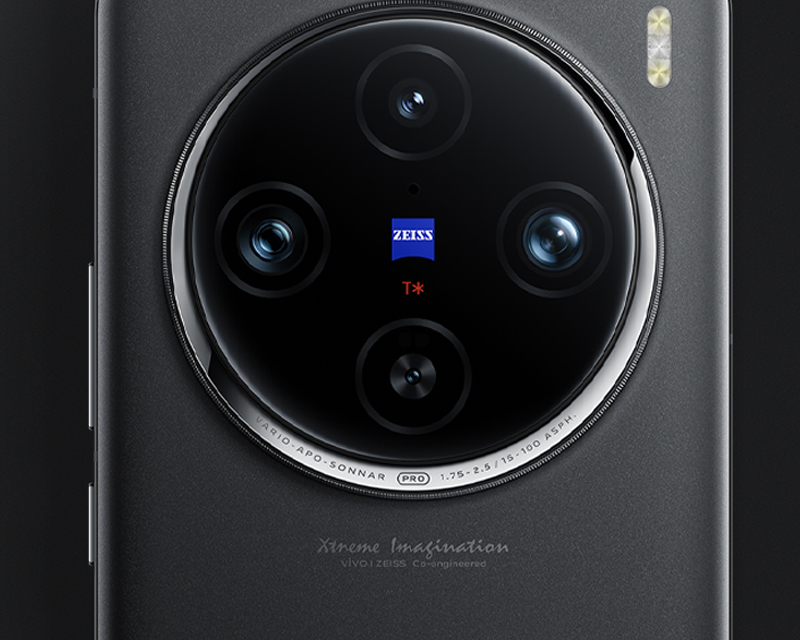
- Primary: 50MP 1/0.98″ sensor, f/1.75-aperture lens, Dual Pixel PDAF, OIS
- Ultra-wide: 50MP, 1/2.76″ sensor, 15mm equivalent f/2.0-aperture lens, AF
- Tele: 50MP 1/2″ sensor, 100mm equivalent f/2.5-aperture lens, AF, OIS
- Video: 8K, 4K at 60/30fps, 1080p at 60/30fps
iPhone 15 Pro Max

- Primary: 48MP sensor, 2.44µm quad pixels, 24mm equivalent f/1.78-aperture lens, Dual Pixel AF, OIS
- Ultra-wide: 12MP sensor, 13mm equivalent f/2.2-aperture lens, Dual Pixel AF
- Tele: 12MP sensor, 1.12µm pixels, 120 mm equivalent f/2.8-aperture lens, Dual Pixel AF
- Video: 4K at 60/24fps, 1080p at 60/25fps
Daylight Main Camera
When it comes to the main camera, the Vivo X100 Pro boasts a 50-megapixel sensor, while the iPhone 15 Pro Max comes equipped with a 48-megapixel camera. Here are two key points to note:
Firstly, both smartphones use Sony sensors for their main cameras. The Vivo is equipped with the Sony IMX 989 sensor, a large 1-inch sensor, whereas Apple has opted for the IMX 803 sensor, the same one found in the 14 Pro Max.

Secondly, despite its higher megapixel count, the Vivo X100 Pro processes its images to output at 12.5 MP from its main camera. On the other hand, the iPhone 15 Pro Max uses a technology called stacked pixel binning to deliver a 24-MP image output. This comparison is fascinating because it pits a 12.5 MP image from a larger sensor against a 24-MP image from a smaller one.
Both phones produce high-quality images that are sharp, detailed, and visually appealing. To the unaided eye, the differences between them are minimal. However, the Vivo tends to slightly enhance shadows and highlights, leading to a minor over-sharpening effect in its pictures. Upon closer inspection, images from the iPhone appear clearer due to this. Additionally, in certain situations, the Vivo may show a slight reddish tint in its images, as observed in a specific photo of a plant.
Daylight Ultra-Wide Camera
In the ultra-wide camera category, the Vivo X100 Pro features a 50-MP sensor with a 15 mm lens, whereas the iPhone 15 Pro Max uses a 12-MP sensor with a 13 mm lens. Interestingly, their output resolutions are quite similar, with the Vivo producing images at 12.5 MP and the iPhone at 12 MP.

In this comparison, the Vivo X100 Pro stands out for its ultra-wide shots. Its images are more vibrant and sharper than those from the iPhone. The Vivo’s pictures are well-exposed and generally look more appealing than the iPhone’s, which tend to be slightly underexposed and less sharp. Both phones occasionally exhibit a reddish or yellowish tint in their images.
However, when it comes to handling distortion, the iPhone 15 Pro Max performs better. Images of buildings and huts, for example, show less distortion and appear less slanted in the iPhone’s photos compared to those from the Vivo.
Daylight Telephoto Camera

In the telephoto lens category, the differences between the Vivo X100 Pro and the iPhone 15 Pro Max are quite notable. The Vivo uses a 50-MP sensor for its telephoto camera, offering 4.3x optical zoom, which can extend up to 100x digital zoom. It also features floating lens technology, enabling users to take close-up macro shots. Meanwhile, the iPhone has upgraded its telephoto lens in this model, providing a 5x optical zoom with a maximum digital zoom of 25x.

Despite both phones producing images that are well-saturated, sharp, and detailed, the Vivo stands out due to its 50-MP camera and superior resolution, delivering remarkably impressive results that the iPhone struggles to match. However, it’s not a clear-cut victory across all scenarios. At 2x zoom, the Vivo tends to underexpose its images, whereas the iPhone offers more natural-looking results. But as you zoom in further, the Vivo’s images become significantly sharper. This difference in performance becomes increasingly evident at higher zoom levels. At 5x zoom, although the Vivo still tends to underexpose, the sharpness and detail it captures are much superior to the iPhone’s output. By the time you reach 10x zoom, the Vivo’s ability to retain detail and sharpness makes you overlook its exposure issues.

Therefore, it seems likely that users who prioritize detail and sharpness in their zoomed images might prefer the Vivo’s telephoto capabilities over the iPhone’s, despite some of the exposure challenges at lower zoom levels.
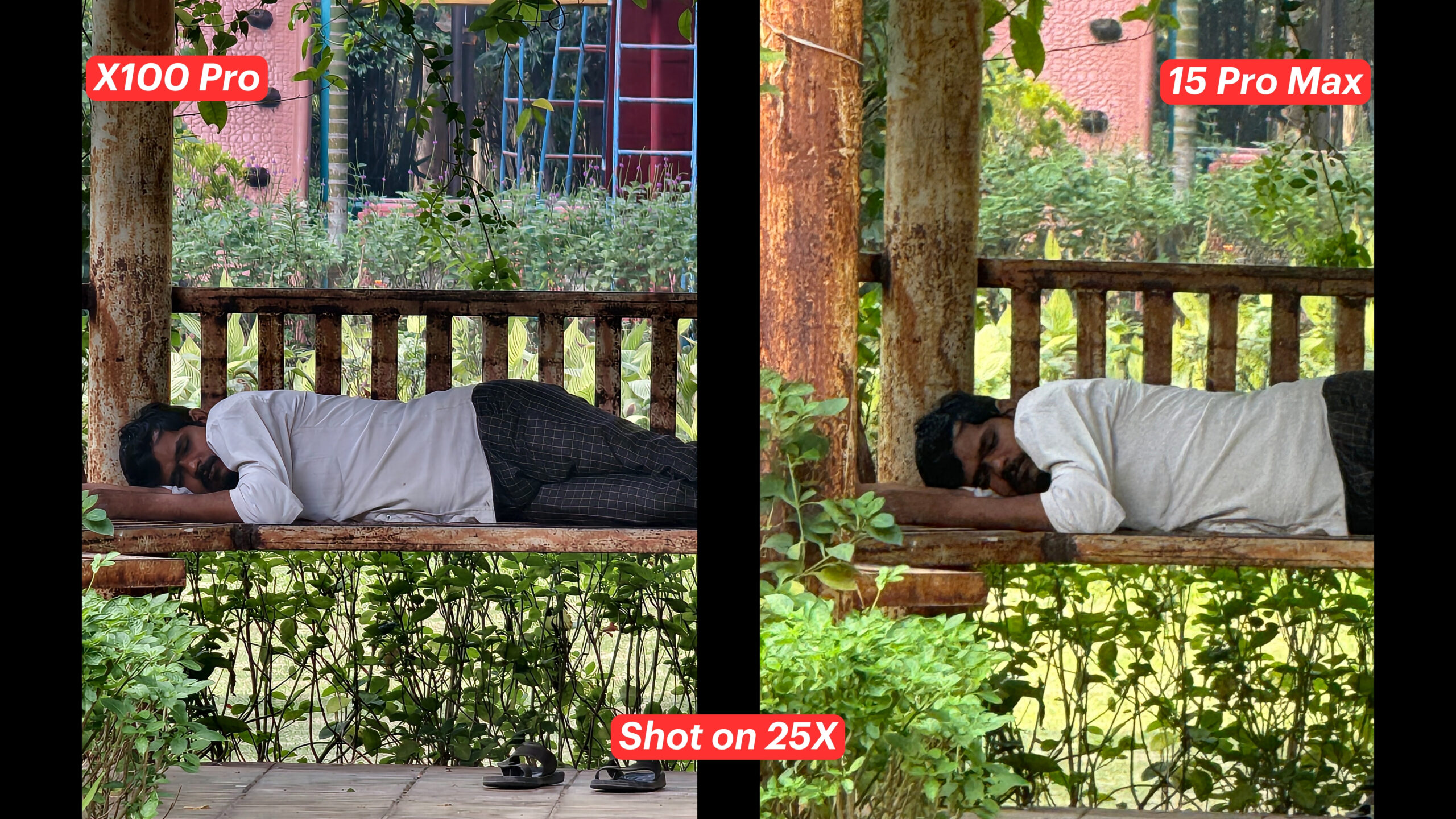
Lowlight Main Camera
In low-light conditions, the performance of the main cameras on both the Vivo X100 Pro and the iPhone 15 Pro Max shows varied results. While both cameras produce images that are vibrant and well-saturated, there are instances where the photos may exhibit a reddish or yellowish tint. The handling of shadows and highlights by both devices is commendable, but there are noticeable differences in their approach to image processing. The Vivo tends to over-sharpen its images, whereas the iPhone opts to make them slightly brighter.

Interestingly, in low-light scenarios, the Vivo often delivers a more natural representation of the actual scene compared to the iPhone. This is particularly evident when zooming into the images, where the Vivo’s photos display superior sharpness. This suggests that users who value a more true-to-life depiction of low-light scenes, with an emphasis on detail upon close inspection, might find the Vivo’s main camera to be more aligned with their preferences.
Lowlight Ultra-Wide Camera
In the ultra-wide category, both the Vivo X100 Pro and the iPhone 15 Pro Max exhibit similar performance characteristics to their low-light main camera results. Images from both devices again show a slight reddish and yellowish tinge. Upon zooming in, the Vivo’s ultra-wide images maintain superior sharpness compared to those from the iPhone, consistent with the trend observed in their main cameras.

However, a notable difference in the ultra-wide performance is the level of distortion. The Vivo’s images show more distortion compared to those from the iPhone. This aspect may affect the overall visual appeal of the images, especially in scenarios where straight lines and architectural features are prominent. Users who prioritize image sharpness might still lean towards the Vivo for its detail retention, but those who are sensitive to distortion in their ultra-wide shots might prefer the iPhone’s performance in this aspect.
Lowlight Telephoto Camera

The tendency of the Vivo X100 Pro to over-sharpen its images, which might be seen as a drawback in some photography scenarios, actually becomes an advantage when it comes to its telephoto capabilities. This characteristic enhances the telephoto images, making them sharper and more detailed, particularly noticeable in daylight conditions.
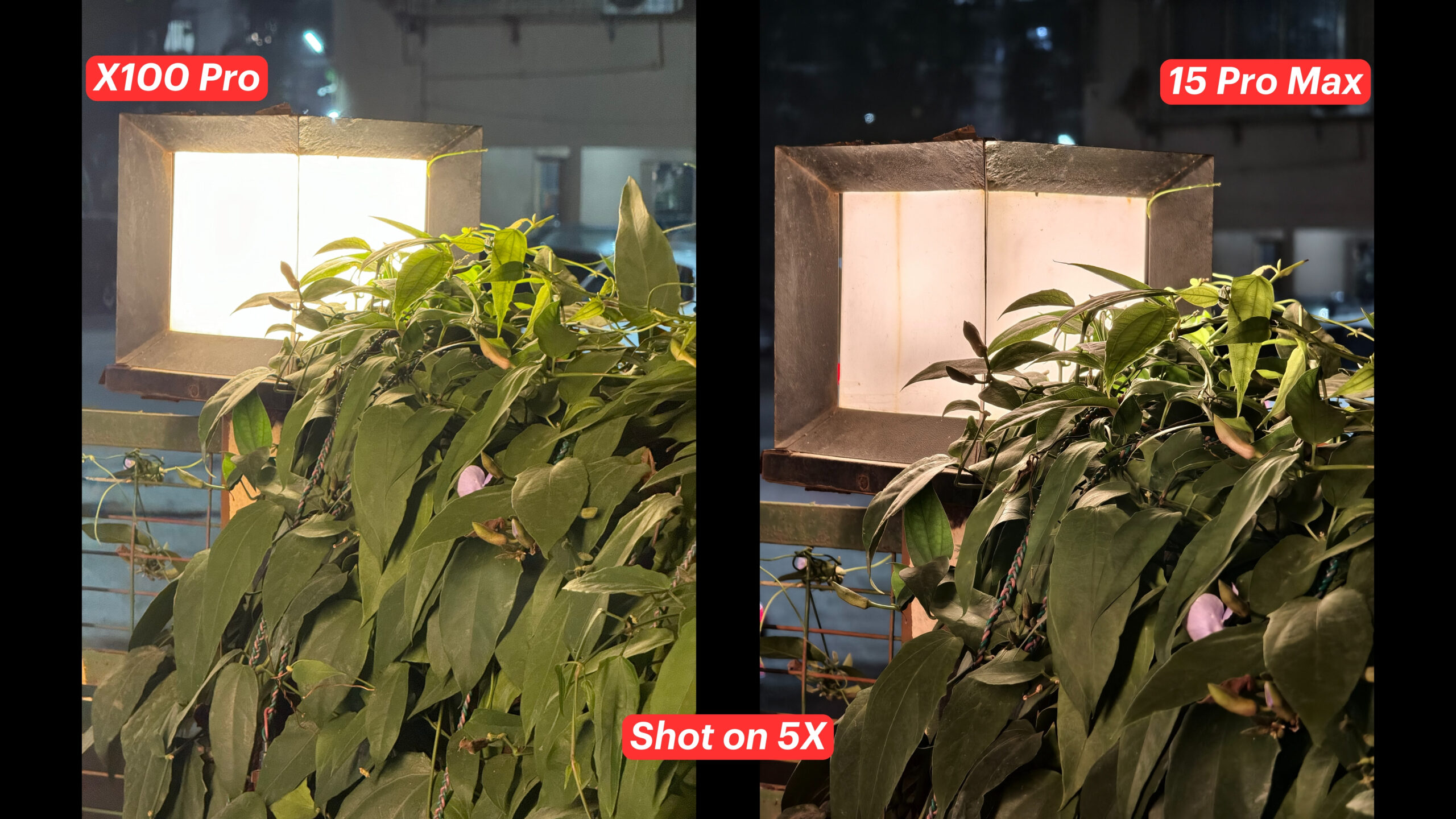
The result is impressively clear telephoto shots that stand out, especially for users who frequently utilize the telephoto lens for zoomed-in photography. This aspect of the Vivo’s performance underscores how its approach to image processing can significantly benefit certain types of photography, showcasing the device’s strength in capturing distant subjects with remarkable clarity and detail.

Macro Mode
The Vivo X100 Pro’s advantage in telephoto sharpness extends impressively into its macro photography capabilities. Thanks to its floating telephoto lens, the Vivo offers a significant benefit: the ability to get extremely close to subjects. Coupled with its super macro mode, the images produced are strikingly well-saturated, sharp, and full of detail.

While the iPhone also supports close-up photography and can capture good quality pictures, it tends to lose focus as you move closer to a subject. This limitation highlights the Vivo’s superiority in macro photography. The Vivo’s ability to maintain focus and detail at very close distances makes it a more suitable choice for users who prioritize macro photography, offering them a level of performance and versatility in close-up shots that is challenging for the iPhone to match.
Portrait Mode
In the realm of portrait photography, the Vivo X100 Pro and the iPhone 15 Pro Max offer different features and results. The Vivo provides users with five focal length options for shooting portraits, whereas the iPhone offers three, giving Vivo users a bit more versatility in how they can frame their subjects.
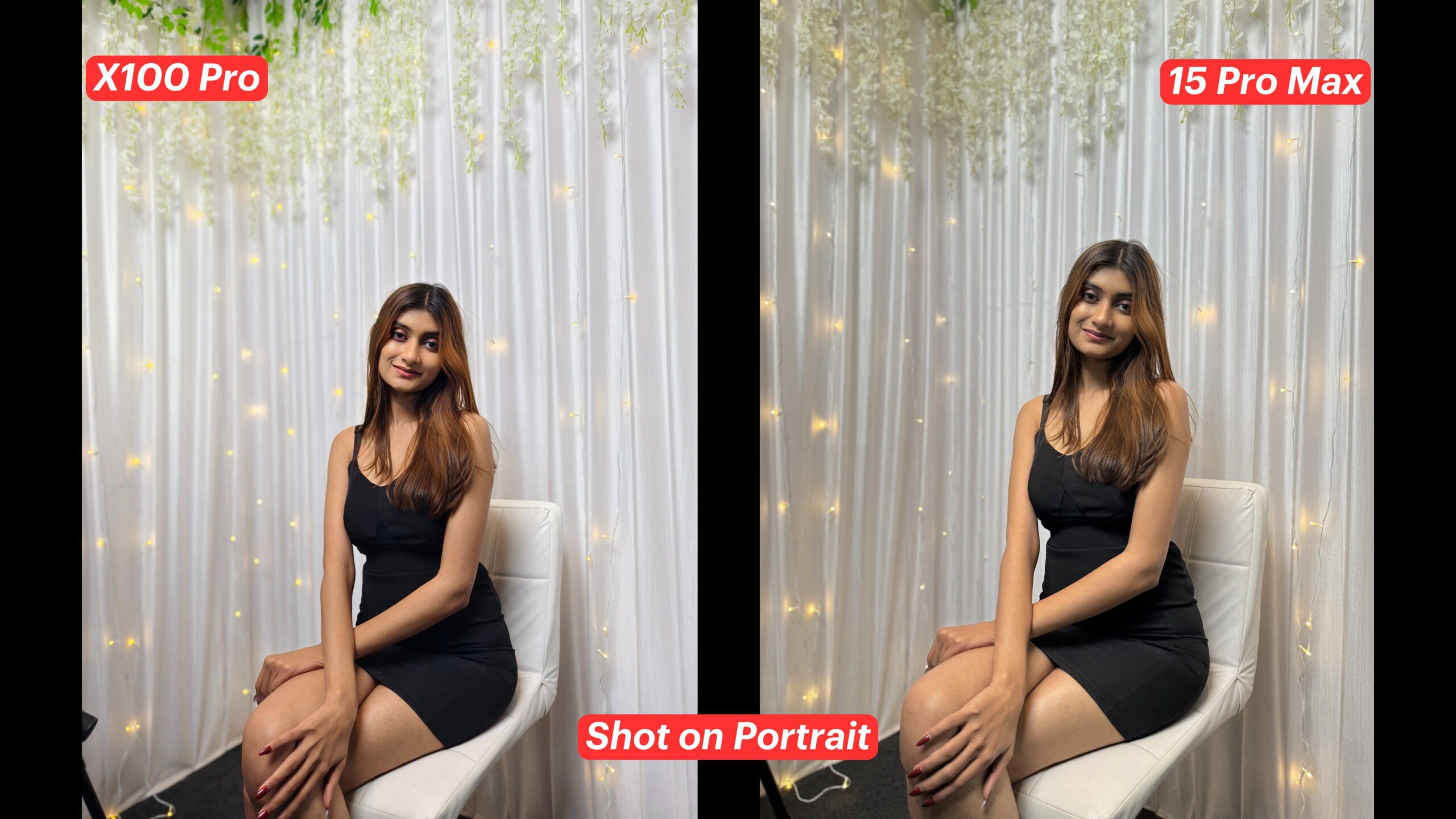
Image quality from both devices is commendable, but they handle portraits differently. The Vivo tends to brighten the exposure and applies a smoothing effect to skin tones, which might appeal to users looking for a more polished look straight out of the camera. In contrast, the iPhone aims to capture the scene as accurately as possible, reflecting the actual lighting conditions and textures without additional smoothing. This approach may appeal to users who prefer a more natural look.
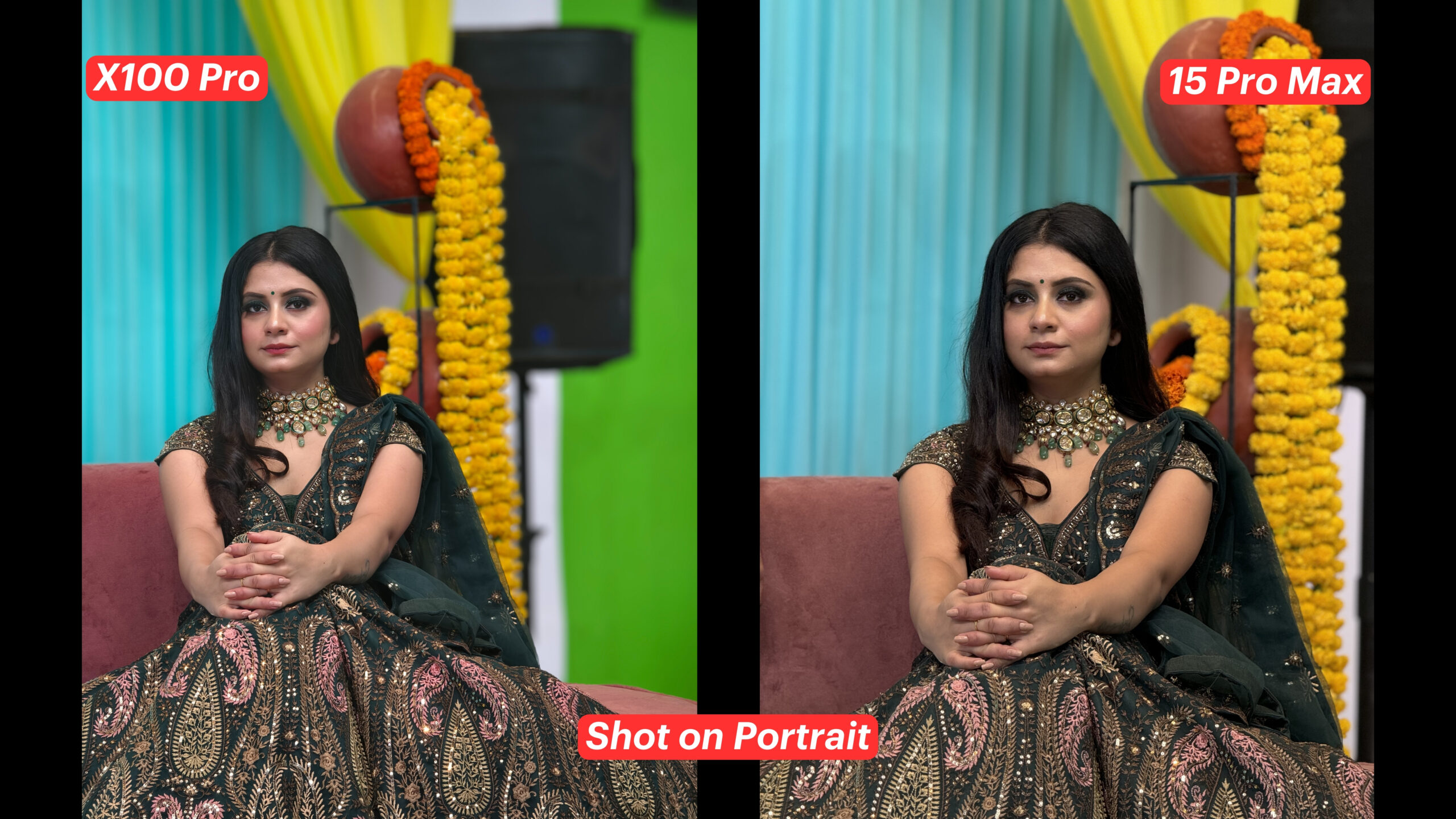
Upon zooming into the portraits, the Vivo’s images appear sharper than those from the iPhone. Both phones perform well in terms of edge detection, accurately distinguishing between the subject and the background. However, the Vivo slightly outperforms the iPhone in this aspect, with its subjects appearing sharper against the background, enhancing the depth effect typical of portrait shots.

This comparison marks a significant observation. Having used iPhones for many years and comparing them against various competitors, it’s been rare to see another phone outperform the iPhone in portrait photography—a domain where the iPhone has traditionally excelled. Yet, in this instance, it appears the Vivo X100 Pro has not only matched but surpassed the iPhone 15 Pro Max in delivering superior portrait photos. This outcome highlights the Vivo’s exceptional capabilities in this photography genre, positioning it as a strong contender for users who prioritize portrait photography.
Front Camera
The iPhone clearly beats the Vivo when it comes to the front camera. Although the iPhone’s front camera is just 12-MP compared to Vivo’s 32-MP, the iPhone still takes better pictures. The Vivo’s pictures often look too sharp and too bright, making them look unnatural. It even smooths out skin tones even when you turn that feature off. On the other hand, the iPhone captures more natural-looking images, especially in portrait mode. However, Vivo’s photos might look more detailed because of the heavy editing, but the results don’t look as real, especially when it comes to eyes and faces.
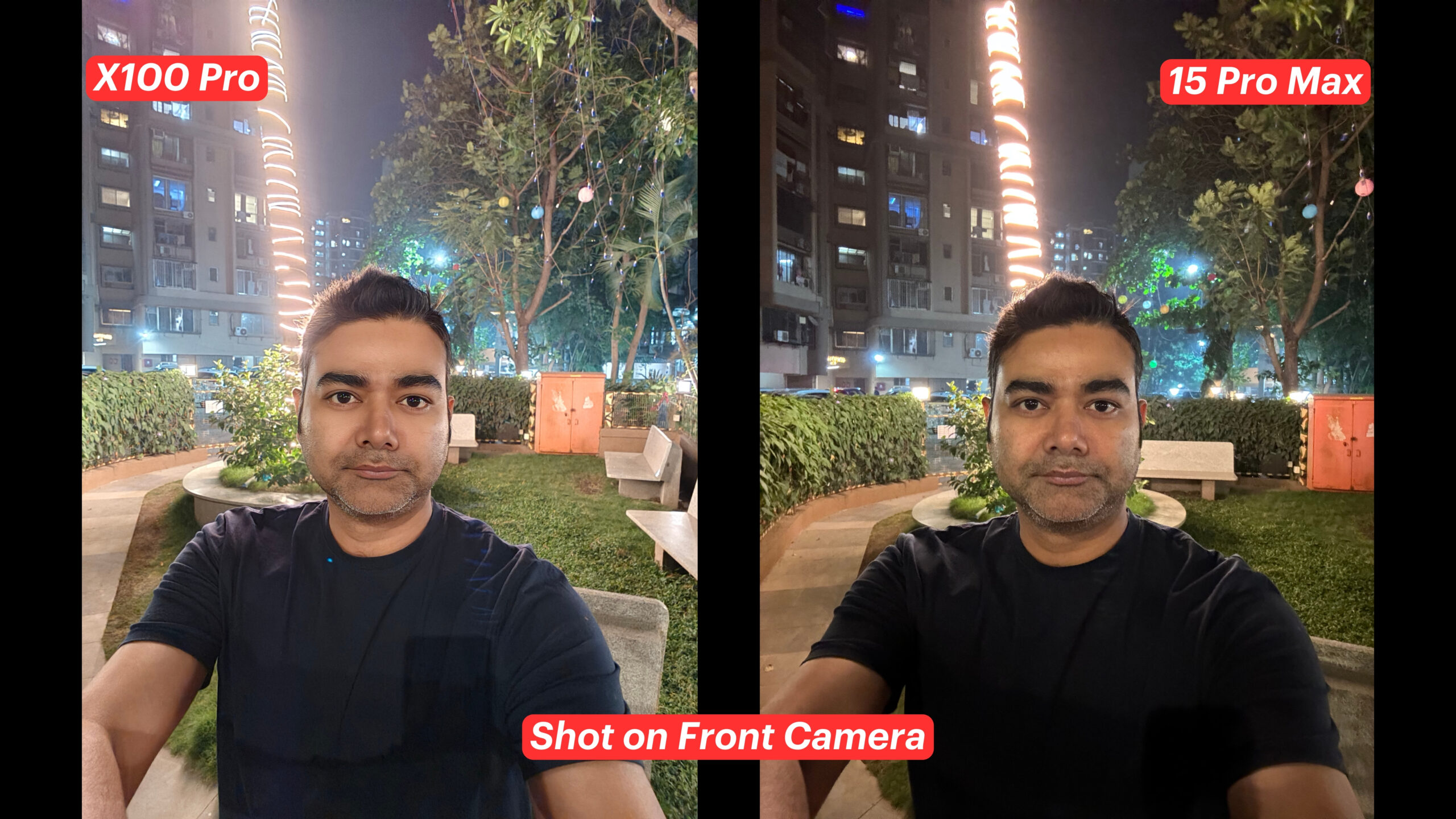
Video quality is another area where the iPhone stands out. The Vivo can only record videos in 1080p, while the iPhone can go up to 4K, offering much clearer and better-quality videos. This was also a point I mentioned in my review of the Vivo X100 Pro, highlighting that the front camera definitely needs improvement.
Video
The Vivo phone can record videos in 8K resolution, which is higher than the iPhone’s 4K at 60 frames per second. However, the iPhone excels in other areas like auto-tracking, HDR, and stabilization, making its video quality appear superior. Although the Vivo’s video quality is impressive on its own, it doesn’t quite match up to the iPhone when directly compared. Additionally, the iPhone offers the option to shoot in ProRes format, a feature not available on the Vivo, providing a significant advantage for users interested in higher-quality video production.
Conclusion
When I began this review, I was almost certain that the Vivo would outshine the iPhone in camera performance. However, I’ve been taken aback by how well the iPhone identifies scenes. Surprisingly, despite having lower megapixels in its non-primary cameras compared to Vivo, the iPhone showcases Apple’s strength in harmonizing software with hardware.
Breaking it down: the iPhone takes the lead with its main camera and also excels in selfies and video quality. On the other hand, Vivo wins in the wide and telephoto lens categories, and its macro and portrait shots are outstanding. What gives the iPhone an edge is its user-friendly interface, which many find appealing.
Yet, when considering the cameras alone, the Vivo X100 Pro emerges as the superior choice.

Breaking it down: the iPhone takes the lead with its main camera and also excels in selfies and video quality.
Yet, when considering the cameras alone, the Vivo X100 Pro emerges as the superior choice.